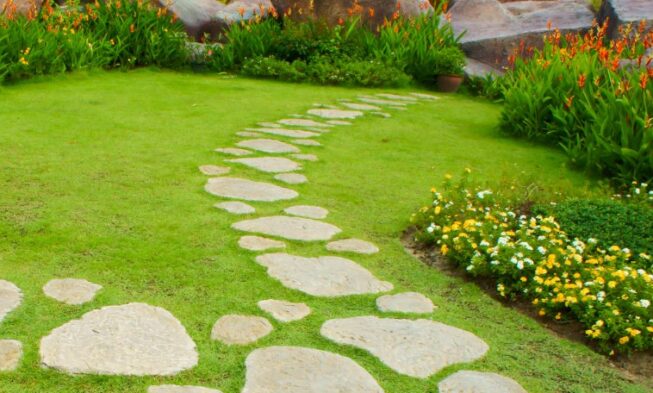A comprehensive guide to Stepping Stones

Stepping stones are among the most underrated paving stones that have been in use for ages. They are an interesting addition to outdoor spaces and come in different shapes and sizes. As the name suggests, Stepping Stones or Steppers are stones or similar materials used in a series used to step on while walking. These stones create pathways through gardens, lawns, fields, or entryways.
Why should you buy Stepping Stones?
- Earlier, Stepping Stones were used as raised surfaces in muddy or waterlogged places. They used to create a stable and higher ground to step on when the walkways or roads were slippery or invisible. This functional aspect remains true. So, if you reside in an area that receives heavy rainfall and your walkways get submerged in water, Stepping Stones come as a respite. Moreover, they are slip-resistant and safe to walk on.
- Additionally, these stones also add to the aesthetic value of your property. Available in a variety of contours and colours, you can get creative with the designs and make your outdoor space look unique. From rectangular to round, there is a plethora of shapes for you choose from.
- If you have a grassy lawn, Stepping Stones will prevent trampling of the lush greens. Instead of walking on the grass, walk on the stones to keep the lawn safe.
- Another advantage of steppers is that they are zero maintenance. Once you seal the stones, they require minimal to no upkeep, keeping your stress at bay.
- The stones also have a great utility as they save a large amount of fertile land from being covered under a straight paving path. Therefore, a maximum number of times, Stepping Stones are round in shape to save space. It also makes them cost-effective.
- You can install Stepping Stones on your own. Installation is simple and does not require precision leveling or excavating a huge base that is generally required in the construction of driveways or patios.
What material should the Stepping Stones be?
There is no universal rule for Stepping Stones to be of any material. You can select any type of stone to create a trail of these steppers. If you have leftover pieces of your stone pavers, use them as steppers. Generally, people use natural stone pavers made of Granite, Sandstone, Limestone, Bluestone as Stepping Stone.
How far should Stepping Stones be from each other?
The most common mistake that one makes while laying the stones is placing them very closely together. An average person’s stride is around 18 inches. Hence, lay the stones in a manner that their centers are 18 inches apart. The distance can be more than this, depending on the space and the number of stones you have. Mark the distance with spray paint or coloured sand for easy placement.
How are Stepping Stones different from outdoor pavers?
The basic difference lies in the name itself. Stepping Stones are used as steppers only. They have 18-24 inches gap between them calculated basis on a human’s normal stride. Outdoor pavers are full-fledged solid pavers with little or no gap between them. Stepping Stones cannot be used on driveways and are limited to gardens, walkways, and entrance paths. Patio pavers are versatile and used across multiple applications. If you have portions of outdoor pavers remaining after cutting, use them as Steppers. But not all Stepping Stone can be used as outdoor pavers.
How do I install Stepping Stones?
Installation of Stepping Stone is a simple DIY task and doesn’t require much labour when compared to laying outdoor pavers. Here are the steps to follow for the installation of Stepping Stones:
- Begin by planning- How wide would the path be, what kind of stones you need, and the design you want to create.
- Once you have the final shape of the Stepping Stone, place them on the path and trace their shape. Doing this will help mark the area where you will place the stones.
- Now remove the stones and dig out the turf/soil. This is the base where the stones would set in. The holes should be 2cm deeper than the thickness of the Stepping Stone.
- Fill the excavated area with builders’ sand, concrete, gravel, or stone dust and set the stones in place. The filling will keep the Stepping Stones in place. In case of stone dust, add about 2 inches thick mixture to each hole, enough to raise the stepper a bit above the ground.If you are paving the path on grass and want to use your lawnmower easily, then keep the stones just below the level of the surrounding soil.
- Wiggle the steppers into the setting bed. Tap with a rubber mallet to get rid of air pockets. You can use a level to set the stones evenly with the corresponding stones. Tap one side of the stepper, inclining it slightly to drain water away from the structures.
And there you go, it’s done!
Summing up
Overall, Stepping Stones are easy to install and easily available. They are low maintenance and sustainable products for your outdoor space. Choose Stepping Stone for your garden or lawn to elevate the aesthetics of your house, without spending a fortune or making much efforts.



